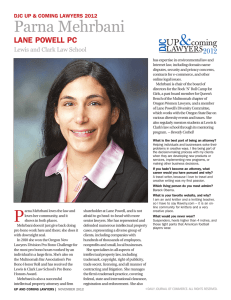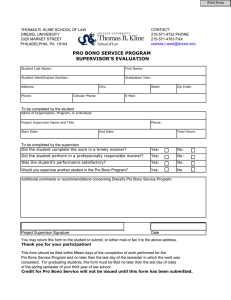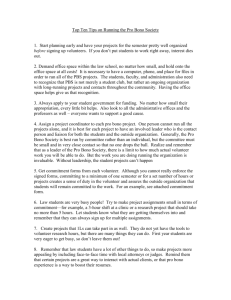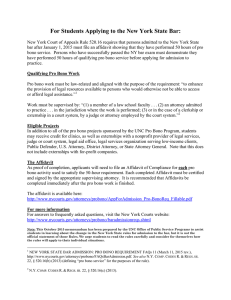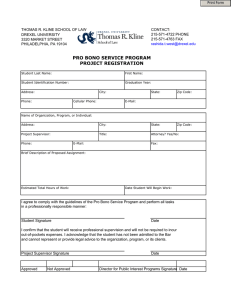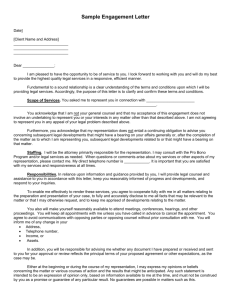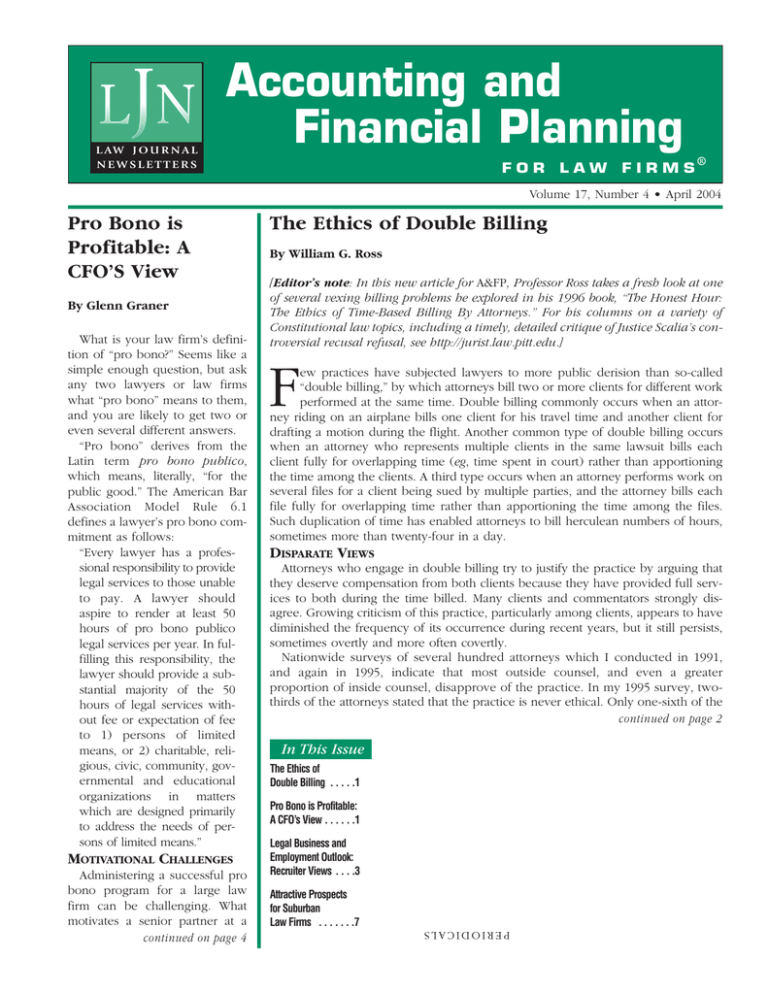
L AW J O U R N A L
NEWSLETTERS
Accounting and
Financial Planning
FOR
LAW
FIRMS
®
Volume 17, Number 4 • April 2004
By Glenn Graner
What is your law firm’s definition of “pro bono?” Seems like a
simple enough question, but ask
any two lawyers or law firms
what “pro bono” means to them,
and you are likely to get two or
even several different answers.
“Pro bono” derives from the
Latin term pro bono publico,
which means, literally, “for the
public good.” The American Bar
Association Model Rule 6.1
defines a lawyer’s pro bono commitment as follows:
“Every lawyer has a professional responsibility to provide
legal services to those unable
to pay. A lawyer should
aspire to render at least 50
hours of pro bono publico
legal services per year. In fulfilling this responsibility, the
lawyer should provide a substantial majority of the 50
hours of legal services without fee or expectation of fee
to 1) persons of limited
means, or 2) charitable, religious, civic, community, governmental and educational
organizations in matters
which are designed primarily
to address the needs of persons of limited means.”
MOTIVATIONAL CHALLENGES
Administering a successful pro
bono program for a large law
firm can be challenging. What
motivates a senior partner at a
continued on page 4
The Ethics of Double Billing
By William G. Ross
[Editor’s note: In this new article for A&FP, Professor Ross takes a fresh look at one
of several vexing billing problems he explored in his 1996 book, “The Honest Hour:
The Ethics of Time-Based Billing By Attorneys.” For his columns on a variety of
Constitutional law topics, including a timely, detailed critique of Justice Scalia’s controversial recusal refusal, see http://jurist.law.pitt.edu.]
F
ew practices have subjected lawyers to more public derision than so-called
“double billing,” by which attorneys bill two or more clients for different work
performed at the same time. Double billing commonly occurs when an attorney riding on an airplane bills one client for his travel time and another client for
drafting a motion during the flight. Another common type of double billing occurs
when an attorney who represents multiple clients in the same lawsuit bills each
client fully for overlapping time (eg, time spent in court) rather than apportioning
the time among the clients. A third type occurs when an attorney performs work on
several files for a client being sued by multiple parties, and the attorney bills each
file fully for overlapping time rather than apportioning the time among the files.
Such duplication of time has enabled attorneys to bill herculean numbers of hours,
sometimes more than twenty-four in a day.
DISPARATE VIEWS
Attorneys who engage in double billing try to justify the practice by arguing that
they deserve compensation from both clients because they have provided full services to both during the time billed. Many clients and commentators strongly disagree. Growing criticism of this practice, particularly among clients, appears to have
diminished the frequency of its occurrence during recent years, but it still persists,
sometimes overtly and more often covertly.
Nationwide surveys of several hundred attorneys which I conducted in 1991,
and again in 1995, indicate that most outside counsel, and even a greater
proportion of inside counsel, disapprove of the practice. In my 1995 survey, twothirds of the attorneys stated that the practice is never ethical. Only one-sixth of the
continued on page 2
In This Issue
The Ethics of
Double Billing . . . . .1
Pro Bono is Profitable:
A CFO’s View . . . . . .1
Legal Business and
Employment Outlook:
Recruiter Views . . . .3
Attractive Prospects
for Suburban
Law Firms . . . . . . .7
PERIODICALS
Pro Bono is
Profitable: A
CFO’S View
Double Billing
continued from page 1
outside counsel, and less than 2% of
the inside counsel, claimed that double billing is ethical even if the client
is informed of the practice. Attorneys
in the surveys appear to practice what
they preached, since more than threequarters of the outside counsel said
that they had never billed two clients
for work performed at the same time.
Fifteen percent said that they had
done this “rarely”; 7% “a moderate
number of times”; and only 1%
“often.” Similarly, of the Texas law
firm associates who responded to
Texas Tech Law Professor Susan Saab
Fortney’s 1999 poll, 86% stated that
they had not engaged in double
billing during the past year. Her survey also found that double billing was
less common among associates at
large firms than those at smaller firms
and less common among highly paid
associates than lesser-paid ones.
Client objections to double billing
may account for the widespread
opprobrium with which so many
attorneys regard this practice.
CASE LAW AND FORMAL
ETHICS OPINIONS
There is little case law or other
authority on double billing — probably because the practice is so difficult
to detect, given that clients rarely
have access to the billing records of
other clients. Even in contests over
fees, courts rarely permit discovery
of the billing records of clients who
are not parties to the litigation. In
addition to questions about relevance, billing records may contain
information that is protected by the
attorney-client privilege.
As explained below, an ABA ethics
opinion strongly condemns double
William G. Ross teaches professional responsibility, civil procedure, and
constitutional law and history at the
Cumberland School of Law of
Samford University in Birmingham,
AL. Previously he earned a history
A.B. at Stanford and a J.D. at Harvard
Law School, and practiced law in
New York City for 9 years. Professor
Ross is the coauthor of “Legal Fees:
Law and Management” (Carolina
Academic Press, 2003).
2
billing, as have most commentators;
but a California ethics opinion is
more generous.
In an extensive discussion of double billing in 1993, the American Bar
Association’s Committee on Ethics
and Professional Responsibility
strongly condemned this practice.
Formal Op. 93-379. In considering
the hypothetical situations of an attorney who bills multiple clients for
work performed during time spent
traveling or in court, the opinion
states that “it is helpful to consider
these questions, not from the perspective of what a client could be
forced to pay, but rather from the
perspective of what the lawyer actually earned.” The opinion concluded
that “a lawyer who spends four hours
of time on behalf of three clients has
not earned twelve billable hours,”
and that “a lawyer who flies for six
hours for one client, while working
for five hours on behalf of another,
has not earned eleven billable hours.”
The opinion explains that “rather
than looking to profit from the fortuity of coincidental scheduling, [or]
the desire to get work done rather
than watch a movie … the lawyer
who has agreed to bill solely on the
basis of time spent is obligated to
pass the benefits of these economies
on to the client.”
Other authorities are less categorical in expressing disapproval of double billing. In particular, California’s
ethics committee, in a 1996 opinion,
concluded that double billing is ethically permissible if an attorney
satisfies her fiduciary duty to a client
by disclosing “this billing practice
in clear, unambiguous terms, to each
client” and by obtaining “each
client’s consent in advance.” The
opinion further cautions that even
under these circumstances, “the
attorney must take care not to charge
the clients an unconscionable fee.”
California State Bar Standing Committee
on Professional Responsibility and
Conduct, Formal Op. 1996-147.
According to the California
Opinion on double billing, “an
attorney who works on two matters
simultaneously is not required to
divide that time equally. However,
continued on page 6
Accounting and
Financial Planning
For Law Firms®
PUBLISHER . . . . . . . . . . . . . . .MARJORIE A. WEINER
ASSOCIATE PUBLISHER . . . . .SOFIA PABLES
EDITOR-IN-CHIEF . . . . . . . . .JOSEPH S. DANOWSKY
MANAGING EDITOR . . . . . . . .STEVEN SALKIN, ESQ.
MARKETING PROMOTIONS
COORDINATOR . . . . . . . . . . . .ROB FORMICA
MARKETING ANALYSIS
COORDINATOR . . . . . . . . . . . .TRACI FOOTES
ART DIRECTOR . . . . . . . . . . . .CLAIRE C. O’NEILL-BURKE
GRAPHIC DESIGNER . . . . . . . .LOUIS BARTELLA
BOARD OF EDITORS
JOSEPH B. ALTONJI . . . . . .Hildebrandt International
Chicago
WILLIAM F. BRENNAN . . . .Altman Weil, Inc.
Newtown Square, PA
JAMES W. DAVIDSON . . . . .Holland & Hart, LLP
Denver
MICHAEL E. MOONEY . . . .Nutter McClennen & Fish, LLP
Boston
HOWARD L. MUDRICK . . . .HM Solutions
Dallas, TX
STEPHEN M.
(PETE) PETERSON . . . . . . .Law Firm Business Institute
Ridgway, CO
EDWARD POLL . . . . . . . . . .LawBiz Management Co.
Venice, CA
JOEL A. ROSE . . . . . . . . . . .Joel A. Rose &
Associates, Inc.
Cherry Hill, NJ
RONALD L. SEIGNEUR . . . .Seigneur Gustafson Knight
LLP CPAs
Denver
MICHAEL D. SHORT . . . . . .Hildebrandt International
Washington, DC
LISA R. SMITH . . . . . . . . . .Hildebrandt International
Washington, DC
JOHN T. WILKE . . . . . . . . . .American Express Tax &
Business Services, Inc.
Baltimore
Accounting & Financial Planning for Law Firms ®
(ISSN 898-8102) is published by Law Journal Newsletters, a
division of American Lawyer Media. © 2004 NLP IP Company.
All rights reserved. No reproduction of any portion of this issue
is allowed without written permission from the publisher.
Telephone: (800) 999-1916, Editorial e-mail: steves@palawnet.com
Circulation e-mail: subs@palawnet.com
The publisher of this newsletter is not engaged in rendering
legal, accounting, financial, investment advisory or other
professional services, and this publication is not meant
to constitute legal, accounting, financial, investment
advisory or other professional advice. If legal, accounting,
financial, investment advisory or other professional
assistance is required, the services of a competent
professional person should be sought.
Accounting & Financial Planning P0000-231
Periodicals Postage Pending at Philadelphia, PA
POSTMASTER: Send address changes to:
American Lawyer Media
1617 JFK Blvd., Suite 1750, Philadelphia, PA 19103
Annual Subscription: $329
Published Monthly by:
Law Journal Newsletters
1617 JFK Boulevard, Suite 1750, Philadelphia, Pa 19103
www.ljnonline.com
Accounting & Financial Planning for Law Firms ❖ www.ljnonline.com/alm?acctg
April 2004
Legal Business and
Employment Outlook:
Recruiter Views
[Editor’s Note: The following remarks
are excerpted from “The Outlook for
2004: A Recruiter Roundtable,”
published in The Recorder (03-222004). Lawyers, firms and corporate
legal departments can all find reasons for optimism in over a dozen
interrelated trends identified by this
thoughtful panel.]
Chris Braun (publisher of The
Recorder): Tell me what you think we’re
likely to see in the next year or so in
terms of changes in the profession.
Avis Caravello (of Avis Caravello
Attorney Search Consultants): I’m
looking in my crystal ball and I see
three trends that will definitely continue. There’ll be further consolidation of the Am Law 30. The big firms
are continuing their quest to be
global players, coming into regional
markets and acquiring smaller firms,
and gaining more critical mass by
continuing to expand overseas. In
doing so, they are gaining more of a
foothold in large institutional client
bases and thereby continuing to raise
their rates, which hopefully will
result in more work for associates
and more associate hiring.
The other result of that will be that
as rates rise in certain practices that are
more regionalized, we’re going to see
more opportunities for the smaller and
the midsize firms to pick up those
practice groups that are struggling to
keep the rate structure in the larger
global firms. That’s really good news
for the smaller and midsize firms.
The last thing I see, which also goes
to long-term employment opportunities, is in 2 or 3 years there’s going to
be a massive shortage of mid-level to
senior corporate associates, the likes
we’ve yet to see. They have all been
decimated from this market in the
past 2 or 3 years. As things pick up,
firms are going to be looking for
those people. So three or four years
from now, we will have that big
shortage and we’ll be running around
trying to find those folks.
April 2004
Stacy Miller (of Miller, Sabino &
Lee): I’m seeing the continuation of
trends. Law firms are reflecting their
clients and their business models,
whether that be having business people running and managing the firm,
hiring a CEO or COO or what have
you. I’m seeing a lot of firms streamline processes and making partners
and people accountable for their
practices and profitability. That’s
good news for us as recruiters. In the
last couple years I’ve seen a great
increase in retained searches, which
goes hand-in-hand with very focused
efforts on recruiting.
On the in-house side, a lot of my
corporate clients are realizing that it is
time to bring legal work in-house. It’s
much more cost-effective for them to
hire somebody, pay the salary, and
bring them on as an employee of the
company, as opposed to paying outside law firm fees. So I’m seeing inhouse legal departments grow. And
that’s in the very traditional sectors as
well as in the new economy-type
businesses. So I think it’ll be an interesting couple of years.
Hopefully with the hiring of all the
junior corporate associates that’s
going on right now, maybe all those
people will grow up and become
mid- to senior-level associates so that
people aren’t left in a glitch.
David Lacob (of Pacific Search
International): I see five or six big
trends. We will continue to see a dominance and further consolidation of
the Am Law 100 and 200. The national firms that have the resources and
scale are still in the sweet spot. At the
same time, a couple caveats apply. I
don’t think, as has been written in
some press articles, that the Magic
Circle firms will necessarily dominate
the U.S. landscape. They may make
inroads, but I don’t think they will
dominate. They will still have a great
role to play in world markets.
Another thing we’re seeing is that
the nature of how law firms get
business from their in-house clients
is changing. We’ve recently seen
more fee-based bid work. I think
that’s a trend that’s going to continue. Some people call it an auction
model. I don’t know if I’d go quite
that far.
Conflicts for large law firms have
become a massive problem. I don’t
want to say that there’ll be a revenge
of the boutique, but I do concur that
we will see more boutiques; however
they will be a different kind of boutique than we’ve seen in the past. One
example of that is the midsize powerhouse litigation firm. There are a number of examples that I could cite in
that area. I think that’s a trend we’re
going to see, sort of a muscular, midsize litigation boutique. Another trend
that’s certainly going to continue is
international work, particularly in Asia.
The demand for people who have
engineering and hard science backgrounds will continue, and the
demand for language — Mandarin,
Taiwanese, Cantonese, Japanese.
There’s massive competition for people with that kind of background and
skill set, and that’s going to continue.
Some advice for very young lawyers
or people planning to go to law
school is think engineering, think science, think languages, and think
China. Certainly I think these are
areas where we’re going to see a lot
of excitement in the coming years.
Stephen Van Liere (of Cushing
Bicksler Van Liere): I agree that this
trend towards the largest firms focusing on premium billing will continue.
It’s almost reshaping the notion of
what a full-service law firm is. Those
are the firms that built broad practices
to handle all the legal needs of their
clients, but that sort of runs right in
the face of trying to focus only on
premium billing-rate practices. As Avis
pointed out, it’s going to create
opportunities for firms that have a rate
structure that’s one notch below a
premium billing rate structure. They
will be able to pick up practices like
employment, real estate, wealth management and other kinds of practices
that still draw a nice rate, but maybe
not the premium rate.
I see a continuation of this trend
toward creating more levels of
involvement and/or ownership in a
law firm, which began as a way for
some firms to de-equitize partners in
order to increase their per-partner
profit numbers to make them more
attractive merger candidates.
continued on page 4
Accounting & Financial Planning for Law Firms ❖ www.ljnonline.com/alm?acctg
3
Recruiter Views
continued from page 3
A collateral effect (and I think a
benefit) is that firms are starting to
look a little more creatively at what a
partner in a law firm is, what an associate is, what an of counsel might be.
You see a plethora of titles now,
whereas before it was simply either
equity partner or associate. I hope
that trend continues, because it
allows for more flexibility in work
arrangements for people who want
to be lawyers but don’t necessarily
want to be an associate on an
equity-partner track. That’s important
given the demographics of law students and lawyers who are trying to
balance family and everything else.
The third element I’m curious about
— I don’t know if it will actually
develop into a trend — is related to
the in-house side. There was an
excellent article in your publication
about what was called the Dupont
Pro Bono is Profitable
continued from page 1
prestigious, large law firm to oversee
400 different AIDS victims cases?
What motivates the general counsel
of a Fortune 100 company to appear
in court monthly in a protectionfrom-abuse action? Will every lawyer
have the same level of commitment?
Will every law firm permit that level
of commitment?
In its July 2003 Am Law 100 article,
The American Lawyer published pro
bono statistics for the 100 largest law
firms in the country. The results are
strikingly uneven. While many law
firms contribute mightily to the pro
bono cause, 70% of the top-100 law
firms average less than the 50 hours
per lawyer proposed by ABA Model
Rule 6.1.
Glenn H. Graner, CPA, is the CFO
of Kirkpatrick & Lockhart LLP
(www.kl.com), resident in its Pittsburgh
office. K&L’s strong commitment
to pro bono work is all the more
impressive given the firm’s no-debt
philosophy requiring that growth
be funded exclusively with partner
capital contributions.
4
Method, this idea that corporations
will start to outsource the more commoditized aspects of legal work. I’m
very curious whether that will take
hold, because it would have a significant effect on recruiting and hiring
practices. It would have a significant
effect on my business, because we
also do contract attorneys and legal
professionals. So it’ll be interesting to
see whether that is just sort of the latest “in vogue” management technique
or whether it’ll actually happen.
Chuck Fanning (of Major Hagen
& Africa): On the staffing side, I think
we’re in a pretty interesting spot right
now. We’ve gone through a period
where associate hiring, particularly
through recruiting firms, was almost
zero for a period of time. Now it
appears to be picking up quite dramatically. I predict that we will see
the continuation and extension of a
trend that has already started in the
partner recruitment area: law firms
being much more strategic about
how they approach lateral hiring and
the use of recruitment firms. When it
comes to making important hires,
whether it be in the partner or the
associate realm, I just don’t think the
old model of tossing those needs out
to a bunch of search firms on a contingent basis has worked very well.
Corporations long ago discovered
the benefits of partnering more
closely with a recruitment firm to
execute on important hires; in fact,
contingent search is the exception
rather than the rule with respect to
our firm’s in-house search practice.
In the last couple of years, law firms
have increasingly dipped their toe
into the water of retained search at
the partner level. I think we’ll continue to see that, and also the extension
of more exclusive or at least semiexclusive relationships in the associate hiring realm.
Adding to the challenge is the negative financial connotation that is
sometimes associated with a pro
bono commitment. Ask many law
firm managers what “pro bono”
means to them, and all too often you
get the wrong answer. Many will
take the short-term perspective that
a pro bono commitment will cost too
much time and money. We have to
have xxxx billable hours first! How
can we motivate a lawyer to perform
non-paying work? How can we
reward lawyers financially for nonpaying pro bono work? This shortterm perspective is counterproductive, even financially, for a number
of reasons.
to understand the positive effect a
pro bono program can have on a
law firm’s profitability.
Clients care. First, and perhaps
foremost from a financial perspective, a firm’s long-term commitment
to pro bono work matters to clients.
Just as diversity is becoming increasingly important to the client community, so is a law firm’s pro bono
commitment. Clients will take notice
whether or not a law firm is meeting
its professional obligation, and any
law firm leader would agree that
losing an esteemed client would be
a lot more harmful to the bottom
line than the short-term investment
in pro bono activities. Further, pro
bono activities can provide an excellent opportunity to strengthen an
existing client relationship by partnering with clients on pro bono initiatives. Such partnering activities
can also serve as a great training
device for young lawyers at both the
law firm and the client, thus
strengthening not only the client
relationship at the highest levels, but
also building relationships at the
youngest levels.
continued on page 5
TAKING
THE
LONG VIEW
Yes, in the short term there will be
a cash investment cost to a pro bono
commitment, because a law firm
will have to fund certain costs of the
pro bono engagement. And, yes,
there will be a short term opportunity cost in the lost billable hours
you otherwise would have collected, provided there is paying work at
the ready. But one must look to pro
bono work as a long-term commitment
—❖—
www.ljnonline.com/alm?acctg
Accounting & Financial Planning
for Law Firms ❖ www.ljnonline.com/alm?acctg
April 2004
Pro Bono is Profitable
continued from page 4
As further evidence that pro
bono activities matter to the client
community, there has recently been
an increasing trend for prospective
clients to seek information about a
law firm’s commitment to pro bono
activities in “requests for proposals”
for legal work. A law firm can certainly explain its commitment to pro
bono in proposals; however, what
really helps to win new clients is listing the awards that a firm has
received for its outstanding work in
the pro bono field.
Lawyers care. Second, in the
long term, pro bono matters to
lawyers, because many lawyers take
their professional obligation very
seriously. To be financially successful, any law firm must be able to
attract and retain the best and brightest attorneys possible. You do not
want to lose a star lawyer or a potential rainmaker because of a lack of
commitment to a pro bono program.
From an associate-retention perspective, one must understand that
the single largest hidden cost to any
law firm is attorney attrition. It is not
unusual for a large law firm to lose
money on every first-, second- and
third-year associate. And, while a
fourth-year associate may become
profitable, the law firm doesn’t
instantly recoup the losses from the
earlier years. On a cumulative basis,
the firm doesn’t really profit until an
associate reaches his or her fifth
year. So if the firm’s pro bono program helps retain even a single associate into and past the fifth year, the
long-term profitability impact will be
substantial. Similarly, landing that
premier lateral associate or law
review editor who noticed your firm
has won distinguished awards for its
pro bono activities will reap longterm rewards.
Development benefits. Third,
in the long-term, pro bono also
matters because of the training and
professional development opportunities it provides to junior lawyers.
A well-managed pro bono program
can provide a wide variety of
April 2004
high-quality skills training at a relatively low cost; at the same time, it
affords junior lawyers greater
autonomy while still being supervised by senior attorneys. This is
crucial because the economic
demands of the current legal environment don’t provide the same
“second chair” training grounds of
the past. What junior lawyer doesn’t
want to get into a courtroom? What
junior lawyer wants to toil in document privilege review sessions for
long periods without looking forward to some different, challenging
and “fun” project? Sprinkling in the
occasional pro bono experience
will keep your junior lawyers
happy, engaged and looking forward to a brighter future. Associate
morale will be enhanced. And,
again, retention of just one junior
lawyer will reap long-term financial
rewards.
Morals and morale. Fourth,
again in the long term, pro bono
matters because it’s right and
because it feels good. This may
sound trite, but there is no warmer
feeling a lawyer can experience, particularly a junior lawyer, than when a
victory is secured in a protectionfrom-abuse case, a landlord-tenant
dispute, or any other important legal
matter where the victim otherwise
wouldn’t even have been in court
due to financial limitations. The “feel
good” work that pro bono opportunities present for junior lawyers can
occur much more frequently than
victories in the client community and
therefore will result in higher morale
for all involved; and that is always
good in the long term.
BOOSTING PRO BONO: A
COORDINATED APPROACH
In today’s increasingly competitive
legal environment, how can we as
law firm leaders make junior lawyers
feel good about performing pro
bono work? How can we make them
feel that their non-billable time is not
wasted? How can we make them feel
that they will get the same level of
support and training on a pro bono
matter as a client billable matter?
There has to be a clear, top-down
strategic mission statement from the
law firm indicating that pro bono
matters. This mission statement must
have the following characteristics if it
is going to be taken seriously:
• Associates have to know that their
pro bono time counts, that they
will get rewarded for it, and they
will not be penalized in any way
for it. This is particularly important
given the billable hour environment all lawyers live with today.
Meeting this goal is easy enough,
though: pro bono hours should
count the same as billable hours,
within reason.
• Associates have to know that their
pro bono activities will be supervised, reviewed and evaluated by
senior associates and partners, just
as any client billable work would be.
• Not every junior lawyer can find a
pro bono matter on his or her own.
The firm must set up an organizational structure that seeks out pro
bono opportunities, matches those
opportunities with the appropriate
lawyers, and mentors and supervises the junior lawyer to the conclusion of the matter.
• Partners have to buy into the mission statement. Beyond committing
to fulfilling their own pro bono
obligation, partners should also be
called upon to supervise junior
lawyers. Partners must understand
that mentoring a junior lawyer on
a pro bono matter is every
bit as important as mentoring a
junior lawyer on a client matter.
How can a law firm get general
buy-in and acceptance from the
continued on page 8
LAW JOURNAL
NEWSLETTERS
REPRINT SERVICE
Reprints of this article or any other
article published by
LAW JOURNAL NEWSLETTERS
are available in bulk quantities.
Call Syndia Torres
at 212-545-6111 or e-mail
storres@amlaw.com
for a free quote.
Reprints are available in
paper and PDF format.
Accounting & Financial Planning for Law Firms ❖ www.ljnonline.com/alm?acctg
5
Double Billing
continued from page 2
the attorney who fails to do so must
fully and timely disclose the nature
of her billing practices to her client.”
The Opinion also explains that a fee
agreement that is silent on the subject of double billing should be interpreted in the client’s favor.
The California Opinion strikes the
proper balance between protecting
clients and permitting attorneys to
recover full value for efficient use of
time. If, as the ABA opinion states,
the touchstone of ethical billing is
compensation for what the lawyer
earned, one may argue that a lawyer
earns a fee from both clients when
he performs a productive service for
both, even if those services are rendered at the same time.
EFFICIENCY
AND
WINDFALLS
Prohibiting double billing can be
viewed as encouraging inefficiency.
Faced with the painful choice
between wasting his time or losing a
fee, an attorney might opt to perform
tasks on two separate occasions that
could have been performed all at
once. An attorney, however, has an
ethical duty to work in an expeditious manner that spares the client
from unnecessary fees.
Conversely, double billing can be
viewed as ethical insofar as it does not
increase the amount of the bill that
either client would have paid if the
work had been separately performed.
If, for example, the attorney who is
traveling for Client A had read a magazine rather than drafting a motion for
Client B during an airline flight, he
would have charged Client A the same
amount of money. Similarly, Client B
is going to receive the same bill
regardless of whether the attorney
drafted the motion on the airplane or
in his office. This reasoning is subject
to two qualifications, however, both
derivable from the above-mentioned
rule that the lawyer must spare the
client unnecessary fees (or, with somewhat less force, from the California
Opinion’s own caution that such fees
must not be unconscionable).
First, an attorney must reduce or
discount her billable time to account
6
for any distraction or diminution in
efficiency created by work for another client. If, for example, the writing
for Client B takes the lawyer longer
while on the plane for Client A than
it would have taken in the lawyer’s
usual workplace for Client B, then
the lawyer should correspondingly
discount her charges to Client B.
Second, this proposed justification
for double billing assumes that two
different clients are being billed. If,
during a plane trip for a client, the
lawyer does an hour of writing for
that client, then the lawyer may
charge for that hour only once.
Moreover, suppose a lawyer traveling
for Client A has two hours of writing
work to do, one for Client A and one
for Client B. Suppose further that
there will be only one hour of good
writing time on the plane flight, so
that the other hour of writing will
have be done that evening in the
hotel. The lawyer should devote the
hour of writing time on the plane to
Client A rather than Client B, so as to
spare Client A from an avoidable second hour of billing.
Although the ABA opinion suggests that the ability to bill two
clients at once constitutes a windfall,
the ABA’s standard would permit the
client to reap a windfall. Since the
attorney has indeed earned two fees,
an attorney might argue that it is fairer to allow him to reap the windfall
than for the client to receive what
amounts to free legal services.
Of course, clients typically will argue
that they ought to receive the benefit
of any savings because an agent has
a duty to pass economies along to
his or her principal.
CLIENT PERSPECTIVES
Of course, as a practical matter,
many clients will not consent to double billing, agreeing with the ABA
opinion that the attorney should pass
his economy along to the client. It is
quite understandable, for example,
why a client whose attorney represents it in several related lawsuits
would not permit the lawyer to bill
for time spent in a status conference
in each of the four cases. In each
case, the attorney has performed
essentially the same work even
though he arguably has rendered a
distinct service to the client in each
separate case.
A client has less reason to object to
an attorney who bills separate clients
for court appearances scheduled at
the same time or who performs work
for one client while traveling for
another client. In these instances, the
attorney has provided full value to
the first client, who should not object
if the attorney is able to use the same
time on behalf of another client.
CONCLUSION
Like most clients, most attorneys
regard double billing as unethical;
and even most attorneys who wish to
engage in double billing probably
will not dare to seek client consent.
Even if the client consented, the
continued on page 8
STEPHEN M. (PETE) PETERSON JOINS A&FP BOARD
OF
EDITORS
As Managing Director of the Law Firm Business Institute (www.lawfirmbiz.com), Pete Peterson draws on his experience until 2000 as a law firm
CFO in Denver (for Davis, Graham & Stubbs, LLP) and previously in
Minneapolis (for Oppenheimer Wolff & Donnelly). He has also consulted
and served as COO for Hildebrandt International, Inc.
Since 1998, Pete has taught as a Guest lecturer in the Master of Science
in Legal Administration (MSLA) Program of the University of Denver,
College of Law. In May of this year, Pete becomes an Adjunct Professor for
MSLA’s Law Office Management course. In addition, Pete will be presenting, in cooperation with the ALA, a management course for administrators
in the U.S. Attorney’s Office, Department of Justice.
A versatile writer and speaker on a wide variety of legal business topics,
Pete coauthored last year’s three-part A&FP article on law firm surveys. Next
month’s edition will feature an article Pete is coauthoring on advanced education for law firm administrators.
Accounting & Financial Planning for Law Firms ❖ www.ljnonline.com/alm?acctg
April 2004
Attractive Prospects
for Suburban
Law Firms
By Michael C. Hodes
[Editor’s note: Two panelists in the
Recruiter Views article on page 3 note
current economic trends that favor
midsize firms. In this article, the
managing director of a suburban
midsize firm describes how to position such a firm for profitability.]
Over the last 10 years, I attended a
number of leadership, management
and other seminars on the direction
law firms must take to be successful
in the 21st century. Exasperatingly,
our Towson-based firm, just outside
Baltimore, never seemed to fit any of
the categories of firms that were
expected to prosper. We weren’t a
national, regional or international
law firm. We weren’t a boutique.
Yet each year, our firm grew both
in size and financially. In 2003 our
profits-per-equity-member reached
$425,000. We are competitive economically with the large law firms —
and we are having more fun.
Having decided these seminar consultants were missing something, I
began to define a new species of
prosperous law firm I now call “suburban.” This type of firm differs from
traditionally urban-based regional,
national and international firms.
Moreover, it is precisely because
there are inefficiencies in the urban
legal market that talented, welldesigned suburban firms can prosper.
EFFICIENCIES OF
THE SUBURBAN FIRM
The suburban firm has the advantage of being convenient for its client
base: our firm has five offices that are
Michael C. Hodes, Esq. is the
Managing Director of Hodes, Ulman,
Pessin & Katz, P.A., one of Maryland’s
largest law firms. He can be reached
at mchodes@hupk.com or 410-3396770. This article was adapted from
his March 2004 article in A&FP’s
sibling publication Marketing the
Law Firm.
April 2004
easy to access and where parking is
a breeze. Parking is also free to our
employees and to the firm, whereas
the monthly cost of parking in the
urban location can range from $150
to $300 per person.
Our offices are more accessible to
employees as well. It’s convenient for
our attorneys to go to a child’s afternoon lacrosse game and then return
to the office to work for a few hours.
By not having to commute into the
city, our lawyers and paralegals gain
4 to 8 hours per week — time they
can spend in the office billing clients,
marketing, and maintaining client
[I]t is precisely because
there are inefficiencies in the
urban legal market that
talented, well-designed
suburban firms can prosper.
relationships. On weekends, it is easy
to stop by the office and spend a few
hours cleaning up one’s desk.
The rent we pay for suburban
office space is 20-40% less than city
rents in Baltimore and Washington.
Overhead for our suburban business
operations is also substantially lower
than for urban firms.
SUBURBAN RECRUITING
SUCCESSES
Lower costs have helped our firm
avoid getting caught up in associate
wage inflation. Offering a compensation level 25-40% less than at larger
urban firms, we can nevertheless
attract talented young associates
from local law schools, who are
ranked in the top 15% of their law
school class. We sell them on quality
of life issues such as lower billable
hour requirements (1800 hours) and
more emphasis on spending time
with their families. They are also
given more client contact and
responsibility at an earlier stage of
their career. We also inculcate our
young attorneys with an entrepreneurial and marketing spirit. We have
found that lifestyle issues and client
interaction are attractive to this new
generation of attorney.
At the same time, our firm has been
able to attract experienced attorneys
with practices at the $150,000$400,000 level. We look for highly
trained and talented attorneys with 815 years of experience. Since the
practices of the attorneys we seek are
generally too small for big urban law
firms, those recruits are less attractive
to the larger regional and national
law firms; moreover, their clients
don’t mesh well with the big firms as
the latter move up the food chain.
For example, we recruited two
attorneys from a large regional firm of
400-plus attorneys. One was a corporate attorney with a cadre of health
industry clients, and the other was a
top-flight healthcare attorney. When
they joined our firm, they were able
to tell their clients that their billable
rates had dropped from the $375$400 an hour range to $290-$310. At
the same time, they were located in a
firm that was only a 5-minute car ride
from the client’s main facility.
In a little over 1 year, both attorneys
substantially increased their practices.
Marketing became easier in the suburban setting, and former clients who
couldn’t afford their fees at the larger
urban firm returned in droves.
FINDING
A
NICHE
With corporate counsel now compelled to watch the bottom line,
the lower prices a suburban law firm
can offer give it a competitive advantage. At the same time, the level of
talent is very competitive when compared to the largest law firms in the
land. In fact, most attorneys in our
suburban prototype have trained and
practiced in urban firms.
A suburban law firm does well to
seek certain types of clients — wealthy
individuals, small businesses, and local
work for public sector representation
and publicly traded companies.
Similarly, the suburban firm should
give priority to such practice areas as
wealth preservation, elder law, healthcare, land use, construction, commercial litigation, environmental, employment, education law, tax and business
law. These areas are where the lowhanging fruit can be found.
continued on page 8
Accounting & Financial Planning for Law Firms ❖ www.ljnonline.com/alm?acctg
7
Pro Bono is Profitable
continued from page 5
must continually monitor and report
on its pro bono efforts to ensure the
firm’s goals are being achieved.
lawyer who decides to stay at your
firm — but for those firms committing to a long-term program, rewards
will become fully evident over time.
partnership at large? Measure the
partners’ commitment to pro bono,
report it, and compensate for it (or at
least make it be known that there
may be compensation implications
for those partners that don’t perform).
• Lastly, as evidence of the firm’s
commitment to pro bono, the firm
CONCLUSION
Double Billing
client or for more than a single matter on behalf of the same client,
regardless of how efficiently the
attorney spent his or her time.
As in the case of billing for “recycled” work (see the August 2003 edition of A&FP), the optimal solution
to double-billing questions may be
to carefully formulate a value-based
alternative billing method in the
letter of engagement. Alternative
billing methods have their own
challenges, but a fair and candid
engagement agreement is the best
way to ensure both conformity with
ethical strictures and a profitable
long-term client relationship.
which still require firms with enough
depth of talent to do the job, including top-flight attorneys who have
handled sophisticated matters.
On the other hand, sophisticated
intellectual property matters, complex securities work, or matters
involving the FCC and FDA should
generally be left to the regional,
national and international urban law
firms. It may also be best for
bet-the-company litigation to be
handled by big firms with extremely
deep talent pools.
CONCLUSION
continued from page 6
attorney would risk the diminution
of good will. Since an attorney
normally cannot use billing methods
of which a client disapproves, an
attorney who has not sought and
obtained a client’s consent may not
bill a client for time spent for another
Suburban Law Firms
continued from page 7
As a regional, national or international firm grows, so does the size of
the client it desires to represent. Now
it is marketing to automobile makers,
large hospital chains and insurance
companies. No longer does the big
firm want to represent the local auto
dealership group or community hospital. The suburban law firm with 50150 attorneys can therefore now
compete for those midsize clients,
In the long run, a successfully
administered pro bono program will
have positive financial benefits for
any law firm. Those financial benefits
may not be easily quantifiable — eg,
how can one gauge the “newfound”
profits generated by a great young
For even FASTER service, call or fax to:
Tel: (215) 557-2300 or (800) 999-1916
Fax: (215) 557-2301
[Editor’s Note: I’m pleased to report
that the author has already begun
preparation of a follow-up article on
some advanced pro bono topics.]
—❖—
—❖—
Large urban-based and boutique
law firms are not the only species
that have the potential to prosper.
The well-designed and astutely
positioned suburban law firm is a
firm model that can profitably
provide high value to clients
while also offering an attractive
lifestyle to its own professional and
administrative staff.
—❖—
On the Web at:
www.ljnonline.com
Yes! I’d like to order Accounting and Financial Planning for Law Firms® today!
Now just $279* (regularly $329…save $50!)
*Offer valid to new subscribers only
BD 3038-2004
❑ Send me a sample issue of:
❑ Check Enclosed
❑ VISA
❑ MasterCard
❑ Bill Me
The Corporate Counselor®
Total Amount Due______________**
Account Number______________________________ Exp. Date_____________________
Signature ____________________________________ Telephone ____________________
*Please make checks payable to Law Journal Newsletters.
**Customers in GA add 4% sales tax; customers in AZ add 5.6%, customers in TX add 8.25%, customers in Washington, DC add 5.75% sales tax.
Name_________________________________________________
Address_______________________________________________
City___________________________ State/Zip_______________
e-mail ________________
Law Journal Newsletters
1617 JFK Blvd, Suite 1750
Philadelphia, PA 19103-9655
www.ljnonline.com
Publisher’s Guarantee! You may cancel your subscription at any time, for any reason, and receive a full refund for all unmailed issues.
8
Accounting & Financial Planning for Law Firms ❖ www.ljnonline.com/alm?acctg
April 2004

